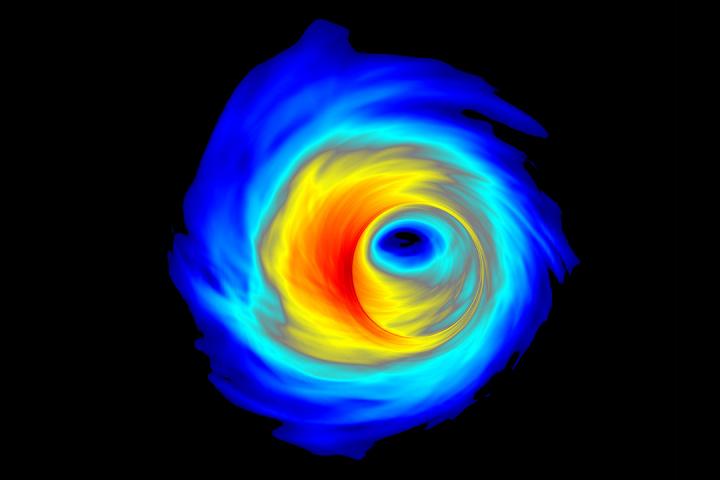Giant 'Pac-Man' Black Holes May Grow by Gobbling Other Black Holes

Like the famous video game superhero Pac-Man, black holes may grow by gobbling up feasts — in their case, other black holes, a new study found.
Simulations suggest that this could happen in the zones just outside the gravitational influence of supermassive black holes, which reside in the hearts of galaxies. In these regions, gravity draws gas, stars, dust and even other black holes to the supermassive black hole.
Black holes drawn to the supermassive black hole get stuck in the disk of matter that surrounds it (known as an accretion disk). Over time, some of these smaller black holes collide, merge, and become bigger and stronger.
Related: Eureka! Scientists Photograph a Black Hole for the 1st Time
This scenario could help to explain a peculiar situation that astronomers observed recently when they detected a merger by measuring gravitational waves (ripples in space-time caused by large interactions in space, such as black holes coming together). Research teams around the world have so far identified 10 black hole mergers, but one of these mergers had unusual characteristics, with higher spin and mass measures than the others. It seemed to be outside the realm of scientists' current understanding.
The next step in understanding this strange merger, and potentially providing evidence that it resulted from a "Pac-Man" merger, would be to find more gravitational waves showcasing the signature of large, spinning black holes, the research team behind the study said in a statement.
"This could be a unique way of probing the physics around these supermassive black holes," Richard O'Shaughnessy, a team member participating in the new study and an astrophysicist at the Rochester Institute of Technology in New York, said in the statement. "It offers unique insight into how the centers of galaxies grow, which is of course essential to understanding how galaxies as a whole grow, which explains most of the structure in the universe."
Get the Space.com Newsletter
Breaking space news, the latest updates on rocket launches, skywatching events and more!
This research was published on Nov. 1 in the journal Physical Research Letters.
- The Strangest Black Holes in the Universe
- No Escape: Dive Into a Black Hole (Infographic)
- Why Are Black Holes So Weird?
Follow Elizabeth Howell on Twitter @howellspace. Follow us on Twitter @Spacedotcom and on Facebook.

Join our Space Forums to keep talking space on the latest missions, night sky and more! And if you have a news tip, correction or comment, let us know at: community@space.com.

Elizabeth Howell (she/her), Ph.D., was a staff writer in the spaceflight channel between 2022 and 2024 specializing in Canadian space news. She was contributing writer for Space.com for 10 years from 2012 to 2024. Elizabeth's reporting includes multiple exclusives with the White House, leading world coverage about a lost-and-found space tomato on the International Space Station, witnessing five human spaceflight launches on two continents, flying parabolic, working inside a spacesuit, and participating in a simulated Mars mission. Her latest book, "Why Am I Taller?" (ECW Press, 2022) is co-written with astronaut Dave Williams.










